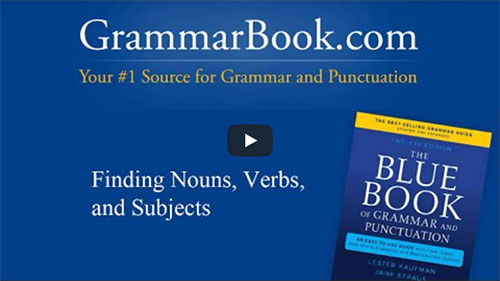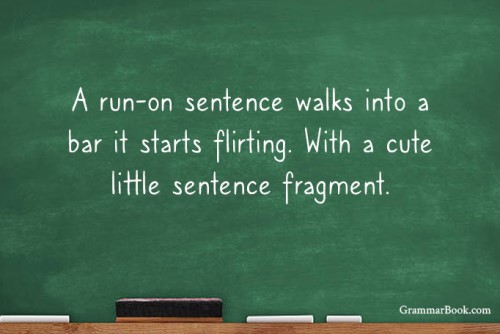|
Many of us have seen a run-on sentence or what we thought might be one. Even if we couldn't explain technically why it was a run-on, we intuited that such a sentence included elements that were either improperly joined or insufficiently separated.
In this discussion, we'll further review run-on sentences as well as different ways to correct them.
What Is a Run-On Sentence?
A run-on sentence is one in which two or more complete, independent clauses are joined without a word or punctuation mark that identifies them as complete.
The primary culprits of a run-on sentence are the comma splice and the fused sentence. A comma splice occurs when two independent clauses are connected (spliced together) with only a comma. A fused sentence "fuses" independent clauses with no punctuation.
Comma splice: The boy runs especially fast, he is also able to change direction quickly.
Fused sentence: The train schedule is being revised commuters will now have more express-route options. |
If you have seen sentences like these before and called them out as being run-ons, you were correct. As we've touched on, the problem here is that independent clauses need markers that identify them as such when two or more appear in a sentence. Such indicators might be a coordinating or subordinating conjunction or a punctuation mark that helps acknowledge the clauses as independent.
In our first example, we have the following two independent clauses:
The boy runs especially fast.
He is also able to change direction quickly. |
To avoid a run-on sentence with a comma splice, we might treat the clauses in the following ways.
Comma with coordinating conjunction: The boy runs especially fast, and he is able to change direction quickly.
Period: The boy runs especially fast. He is also able to change direction quickly.
Semicolon: The boy runs especially fast; he is also able to change direction quickly. |
Our second example also has two independent clauses:
The train schedule is being revised.
Commuters will now have more express-route options. |
With this example, we have even more ways we might join the clauses grammatically.
Comma with coordinating conjunction: The train schedule is being revised, so commuters will now have more express-route options.
Subordinating conjunction: Because the train schedule is being revised, commuters will now have more express-route options. (The conjunction because makes its clause dependent.)
Period: The train schedule is being revised. Commuters will now have more express-route options.
Semicolon: The train schedule is being revised; commuters will now have more express-route options.
Colon: The train schedule is being revised: Commuters will now have more express-route options. |
As precise and eloquent writers, we also want to be mindful of comma splices that can sneak into quotations and make them run-on sentences.
| Comma splice in run-on quotation: "The guests will be here at seven p.m.," Bartholomew said, "please be sure your quarters are orderly before they arrive." |
The two clauses in this quotation are both independent, so we need to properly punctuate them.
| Revised: "The guests will be here at seven p.m.," Bartholomew said. "Please be sure your quarters are orderly before they arrive." |
Correcting a Run-On Sentence: Determine the Context
When we are correcting a comma splice or a fused sentence, we want to be sure we apply a remedy that makes grammatical sense.
For example, consider the following sentence:
| I don't think I'll go to the presentation tonight, it always bores me. |
Here we have two independent clauses ungrammatically spliced by a comma. One way to fix it could be to separate the clauses with a comma and a coordinating conjunction. Let's try that:
| I don't think I'll go to the presentation tonight, and it always bores me. |
We've resolved the comma splice, but does the revised sentence make sense? Not really. However, we can see the two clauses still have a relation that we can connect. Let's try other methods we've mentioned:
Subordination: I don't think I'll go to the presentation tonight, because it always bores me.
Period: I don't think I'll go to the presentation tonight. It always bores me.
Semicolon: I don't think I'll go to the presentation tonight; it always bores me.
Colon: I don't think I'll go to the presentation tonight: It always bores me. |
All four are viable alternatives for expressing the two independent clauses as connected with logical and grammatically correct interrelation.
When a Comma Splice Is OK
There will be times when a comma splice is acceptable within a particular expression or construction. In many cases, the splice will be used to achieve a certain rhythm or creative effect, especially in fiction or narrative reporting:
She was bold, she was fierce, she was proud.
He lived, he loved, he even dared to hope.
The higher they climb, the farther they fall. |
The key to such usage is knowing which grammatical rule is being broken and why. When properly placed and sparingly applied, such phrasing can add to vibrant writing.
Related Topics
Commas with Independent Clauses
Connecting Sentences with Commas and Semicolons
|
View and comment on this
article on our website.
|
|
|

|
Pop Quiz
Determine if each of the following is a complete sentence or a run-on sentence. If it is a run-on sentence, identify the problem (comma splice or fused sentence) and suggest a proper revision.
1. A cat is in the yard let's give it something to eat.
2. The driveway is a sheet of ice, please spread some salt on it.
3. The filming will begin tomorrow; Uri will be the director.
4. The clowns are in the car I want to see them.
|
 |
The Blue Book of Grammar and Punctuation
by Lester Kaufman and Jane Straus |
The Authority on English Grammar! Twelfth Edition Now Available
An indispensable tool for busy professionals, teachers, students, homeschool families, editors, writers, and proofreaders.
Available in print AND as an e-Book! Over 2,000 copies are purchased every month!
To order the book, simply click the link to order the book from the GrammarBook.com website.
|
Free BONUS Quiz for You!
[[firstname]], because you are a subscriber to the newsletter, you get access to one of the Subscribers-Only Quizzes. Click here to take a Finding Nouns, Verbs, and Subjects Quiz and get your scores and explanations instantly!
We will be adding many more quizzes this year to our already substantial list of them. If you have suggestions for topics we have not yet covered, please send us a message at help@grammarbook.com.
|
Hundreds of Additional Quizzes
at Your Fingertips
Subscribe now to receive hundreds of additional English usage quizzes not found anywhere else!
Teachers and Employers
Save hours of valuable time! You may assign quizzes to your students and employees and have their scores tallied, organized, and reported to you! Let GrammarBook.com take the hassle out of teaching English!
"Fun to test my skills."
"The explanations really help ... thanks!"
"I can select the quizzes to assign to my students, and then the results are reported to me automatically!"
99¢
QUIZZES
|
Don't need all the quizzes?
You can now purchase the same quizzes individually for ONLY 99¢ each.
Purchase yours here.
|
If you think you have found an error in a quiz, please email us at help@grammarbook.com
|
Wordplay

Pop Quiz Answers
1. A cat is in the yard let's give it something to eat. run-on sentence (fused)
Some possible revisions:
A cat is in the yard, so let's give it something to eat.
A cat is in the yard. Let's give it something to eat.
A cat is in the yard; let's give it something to eat.
A cat is in the yard: Let's give it something to eat.
2. The driveway is a sheet of ice, please spread some salt on it. run-on sentence (comma splice)
Some possible revisions:
The driveway is a sheet of ice, so please spread some salt on it.
The driveway is a sheet of ice. Please spread some salt on it.
The driveway is a sheet of ice; please spread some salt on it.
The driveway is a sheet of ice: Please spread some salt on it.
3. The filming will begin tomorrow; Uri will be the director. complete sentence
4. The clowns are in the car I want to see them. run-on sentence (fused)
Some possible revisions:
The clowns are in the car, and I want to see them.
The clowns are in the car. I want to see them.
The clowns are in the car; I want to see them.
The clowns are in the car: I want to see them.
|
 |
English In A Snap:
68 One-Minute English Usage Videos FREE |
Learn all about who and whom, affect and effect, subjects and verbs, adjectives and adverbs, commas, semicolons, quotation marks, and much more by just sitting back and enjoying these easy-to-follow lessons. Share them with your colleagues (and boss), children, teachers, and friends as well! Click here to watch.
|
|





